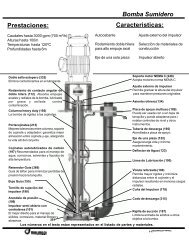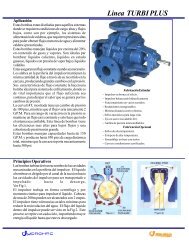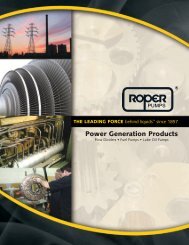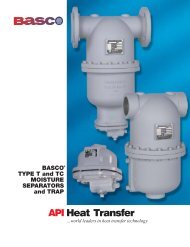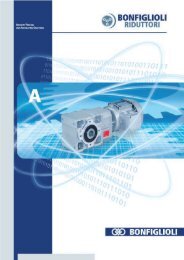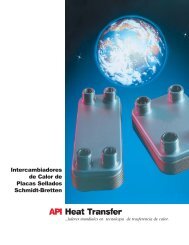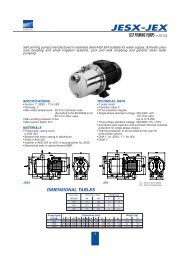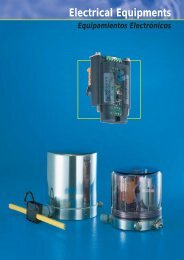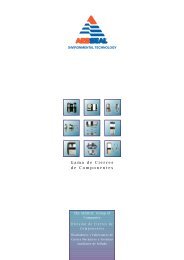Gardner Denver.pdf - inducom
Gardner Denver.pdf - inducom
Gardner Denver.pdf - inducom
You also want an ePaper? Increase the reach of your titles
YUMPU automatically turns print PDFs into web optimized ePapers that Google loves.
Waterjet Basics - Delivering Power<br />
A waterjet nozzle is simply a flow restriction that causes<br />
water velocity to rapidly increase. For inlet pressure above<br />
7,000 psi, jet velocity increases to supersonic. But the jet<br />
loses power due to turbulence created as it flies through<br />
the air. The turbulent zone travels at lower velocity and<br />
does not have enough energy for effective cleaning. At<br />
greater distances away from the jet, the turbulent zone<br />
grows at the expense of the powerful core, until no cleaning<br />
power remains at all.<br />
Turbulence upstream of the jet makes more turbulence in the jet. So abrupt diameter changes, or flow direction changes<br />
must be avoided. StoneAge Attack Nozzle Tips use a flow<br />
straightening device in the orifice that recovers about half the Effect of Turbulence & Standoff Distance<br />
power lost to upstream turbulence. The best quality jets use a<br />
cone-shaped inlet to the orifice to smoothly accelerate the water<br />
Position Jets Close<br />
velocity. Even with the best quality jets, power drops about<br />
6% at 100 orifice diameters, and 62% at 1000 diameters.<br />
Enough to be Effective<br />
As Few Jets<br />
As Big As Possible<br />
for Power<br />
Control Upstream Flow Turbulence<br />
In order to deliver the most jet<br />
power possible to the surfaces<br />
to be cleaned, it is best to use<br />
as few jets as possible, making<br />
each as big as possible. Jets are<br />
rotated to cover all surfaces to<br />
be cleaned. Jet paths look like<br />
the threads on a bolt. This helical<br />
jet path proves very effective<br />
and powerful.<br />
Relative Performance, %<br />
Control Rotation Rate for Maximum Power<br />
A rotating jet moves sideways on the surface to be cleaned. If rotated too fast, this<br />
sideways velocity seriously deteriorates jet quality. We have found that the jet must<br />
be controlled to no more than 22 ft/sec transverse velocity in order to deliver maximum<br />
power to the surface to be cleaned. Of course the bigger the diameter, the lower<br />
the rotation rate allowed.<br />
There are exceptions, but in<br />
most cases the 22 ft/sec<br />
guideline is used whether<br />
we’re cleaning a small pipe, or<br />
a large storage tank.<br />
Standoff Distance, # Orifice Diameters<br />
Jet Velocity at Wall < 22 ft/sec<br />
Pipe ID 4” 8” 18” 36” 60” 180”<br />
Max. RPM 1240 620 280 140 80 27<br />
R<br />
F<br />
What makes it rotate?<br />
Ports in StoneAge nozzle heads<br />
are drilled offset (R) from the axis<br />
of rotation, providing sufficient<br />
mechanical advantage so that the<br />
jet reaction force (F) can rotate<br />
the unit.<br />
Durango, Colorado Phone 970-259-2869<br />
www.stoneagetools.com FAX 970-259-2868<br />
Page 2 © 10/03




